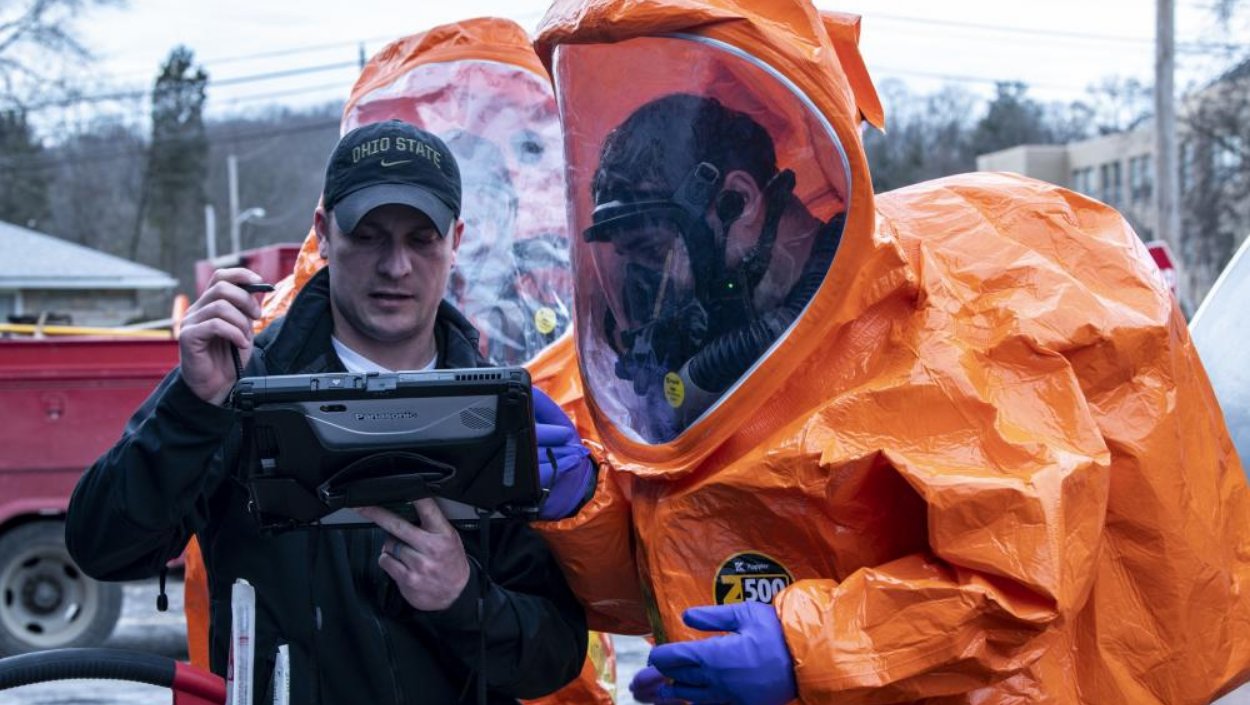

After a 150-car train carrying 20 cars of toxic chemicals derailed outside the village of East Palestine, Ohio, both Ohio and West Virginia activated units from their National Guard to assist in evacuating residents and testing the area for chemical contamination.
The Norfolk Southern train derailed on Feb. 3. Reports suggest faulty brakes caused the crash. In an effort to avoid a larger explosion, authorities set off a controlled burn, which has created a dark pillar of smoke that stayed for days. The train was carrying chemicals including vinyl chloride, monobutyl ether and ethylhexyl acrylate, many flammable.
Ohio Governor Mike DeWine activated elements of the National Guard on Feb. 5. More than 60 soldiers were mobilized, setting up a barricaded zone near the incident and guiding traffic. The village sits near Ohio’s border with Pennsylvania and that state’s governor Josh Shapiro has been providing updates as well on the situation. On Feb. 7 a National Guard civil support team from West Virginia arrived to aid efforts in East Palestine.
Ohio’s 135th Military Police Company arrived to help local law enforcement with the evacuation, guiding people out of the village. Approximately 1,500-2,000 residents were evacuated, according to Mayor Trent Conoway.
Subscribe to Task & Purpose Today. Get the latest military news, entertainment, and gear in your inbox daily.
Meanwhile Ohio’s 52nd Civil Support Team, made up of multiple 2-3 person teams, as well as seven soldiers from the West Virginia National Guard’s 35th Civil Support Team worked to collect air and water samples, testing them for any of the toxic chemicals that had been on the train. They worked in collaboration with the Environmental Protection Agency as well as a company contracted by Norfolk Southern, according to the EPA in a release. A spokesperson for the West Virginia National Guard said its team found no significant readings of any chemicals. The EPA reported on Feb. 14 that it “has not detected any levels of health concern in the community that are attributed to the train derailment.” Tests are ongoing.
Photos shared by the Ohio National Guard on Twitter show guardsmen suiting up in gas masks and full hazmat suits to collect samples in the village. Posted in a since-deleted tweet, a National Guard photo shows the giant pillar of smoke from the crash site and its proximity to East Palestine.

The National Guard regularly responds to disaster emergencies throughout the United States. Lately that has been to help rescue people trapped by extreme snow storms in the northeast or heavy rains in the Midwest. Increased intense weather events exacerbated by climate change have increased the pace of National Guard rescue efforts. Civil support teams are specialized groups focused on assisting in instances where there might be biological, chemical or radioactive substances in disasters or other incidents.
The fire burned for five days, only being fully put out on Feb. 8. That same day DeWine declared that it was safe for residents to return home. Residents have reported dead animals, including fish in creeks, and expressed concerns about the safety of the area.
Despite the ongoing cleanup efforts and cloud of smoke still lingering over the town, the National Guard wrapped up efforts on Feb. 9. The Federal Emergency Management Agency (FEMA) and other federal agencies and departments have sent assistance as well.
The head of Ohio’s National Guard, Maj. Gen. John C. Harris Jr., has drawn heavy criticism after video emerged of him shoving NewsNation reporter Evan Lambert at a Feb. 8 press conference about the derailment and response.
The latest on Task & Purpose
- Here’s why the Marine Corps strapped a rare electronic warfare LAV to the deck of a warship
- Shot fired after intruder breaks onto Andrews Air Force base
- That time a US Navy submarine got a confirmed kill on a train during WWII
- Coast Guardsman saves man hours before graduating from rescue swimmer school
- JTAC vs TACP: A user’s guide to the troops who call in close air support
Want to write for Task & Purpose? Click here.